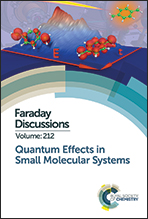Spectral signatures of proton delocalization in H+(H2O)n=1−4 ions†
Abstract
Couplings involving large amplitude vibrations in H+(H2O)n (n = 1–4) are explored using several theoretical approaches. These include harmonic treatments, analysis of harmonically coupled anharmonic oscillator (HCAO) models of the OH stretching vibrations, vibrational perturbation theory (VPT2) in internal coordinates, and diffusion Monte Carlo (DMC). It is found that couplings between shared proton stretches and HOH bends can lead to normal modes that are significantly mixed in character. Couplings between the various OH stretching vibrations are much weaker, and the OH stretches are well-described by harmonically coupled anharmonic oscillator models. Anharmonic couplings and the role of these large amplitude vibrations are further explored using DMC and VPT2. Based on the results of these calculations, it is found that all of the H+(H2O)n ions considered in this study display several different types of large amplitude vibrational motions even in their ground states. In the case of H7O3+, degenerate VPT2 calculations indicate that there are large couplings between the shared proton stretch and various lower frequency vibrations that correspond to motions that break the ionic hydrogen bonds. This leads to vibrational eigenstates that have contributions from several zero-order states.

- This article is part of the themed collection: Quantum effects in small molecular systems


 Please wait while we load your content...
Please wait while we load your content...